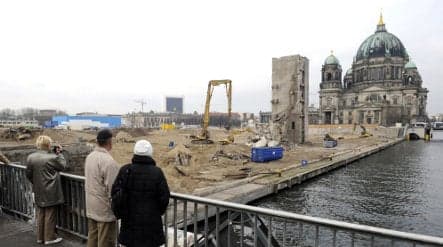East Germans reject palace reconstruction in Berlin

The majority of Germans from the formerly communist eastern states are against the reconstruction of a Berlin palace destroyed by East German authorities after World War II, according to a poll released on Monday.
Some 68 percent of those polled in the eastern states said rebuilding the Baroque palace would be a waste of taxpayer money, magazine Super Illu reported. Just 29 percent of those in the representative poll said they would like to see the 18th Century Hohenzollern palace on Berlin’s Unter den Linden boulevard rebuilt.
Over the weekend Italian architect Francesco Stella won the unanimous support from a jury deciding between 30 different proposals. Architects had to copy three sides of the original rectangular former royal palace but were free to come with their own designs for the final side.
The palace, badly damaged in World War II, was demolished by the communists as a symbol of hated Prussian imperialism in 1950.
In its place the East German authorities went all out, erecting an enormous parliament building made of bronze mirrored glass, steel and concrete called the Palast der Republik that also housed an underground bowling alley and auditoriums.
After East and West Germany reunified in 1990, the building was found to contain large amounts of asbestos. After much debate and vociferous opposition from many nostalgic Berliners demolition began in 2006, a process completed only this month.
Stella's design will cost €552 million.
It will be used to house cultural artifacts and will also be home to cinemas, restaurants, cafes and shops. The German parliament is to take up the plans next year.
After World War II, many German cities - including Berlin - rebuilt damaged and destroyed palaces and historic buildings. But urban planners in both East and West Germany also demolished many ruined buildings on ideological and aesthetic grounds.
The study was conducted for the magazine by the Leipzig Institute for Market Research and included 1,000 participants.
Comments
See Also
Some 68 percent of those polled in the eastern states said rebuilding the Baroque palace would be a waste of taxpayer money, magazine Super Illu reported. Just 29 percent of those in the representative poll said they would like to see the 18th Century Hohenzollern palace on Berlin’s Unter den Linden boulevard rebuilt.
Over the weekend Italian architect Francesco Stella won the unanimous support from a jury deciding between 30 different proposals. Architects had to copy three sides of the original rectangular former royal palace but were free to come with their own designs for the final side.
The palace, badly damaged in World War II, was demolished by the communists as a symbol of hated Prussian imperialism in 1950.
In its place the East German authorities went all out, erecting an enormous parliament building made of bronze mirrored glass, steel and concrete called the Palast der Republik that also housed an underground bowling alley and auditoriums.
After East and West Germany reunified in 1990, the building was found to contain large amounts of asbestos. After much debate and vociferous opposition from many nostalgic Berliners demolition began in 2006, a process completed only this month.
Stella's design will cost €552 million.
It will be used to house cultural artifacts and will also be home to cinemas, restaurants, cafes and shops. The German parliament is to take up the plans next year.
After World War II, many German cities - including Berlin - rebuilt damaged and destroyed palaces and historic buildings. But urban planners in both East and West Germany also demolished many ruined buildings on ideological and aesthetic grounds.
The study was conducted for the magazine by the Leipzig Institute for Market Research and included 1,000 participants.
Join the conversation in our comments section below. Share your own views and experience and if you have a question or suggestion for our journalists then email us at [email protected].
Please keep comments civil, constructive and on topic – and make sure to read our terms of use before getting involved.
Please log in here to leave a comment.